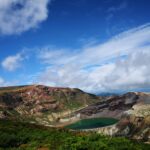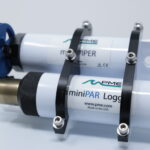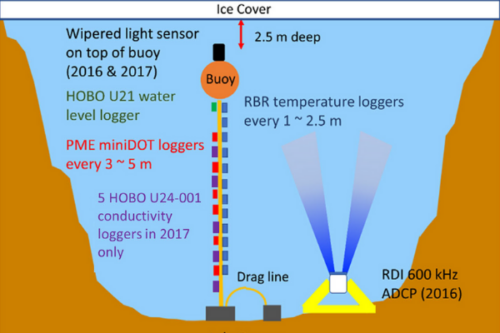The miniDOT® Logger is a completely submersible instrument that logs dissolved oxygen and temperature measurements. The oxygen sensor is an optode that measures dissolved oxygen concentration in water through a fluorescence method. Data are recorded to an internal SD card. Operation of the miniDOT® Logger such as setting the time and sample interval can be accomplished via the USB cable. The miniDOT® is capable of depths of up to 100m while withstanding temperature ranges of 0-35ºC.

miniDOT® Loggers Help Determine if Beaver Ponds are Nitrogen Sinks
September 28, 2021
Project Oyster Case Study
May 26, 2022Under Ice Phenomenon Studied with the Help of miniDOT® Loggers
Project Details
- PRODUCT(S): miniDOT® Logger
- APPLICATION: Surface Water
- PARAMETER: Dissolved Oxygen, Temperature
- LOCATION: Kempenfelt Bay, Lake Simcoe, Ontario, Canada
- ORGANIZATION: University of Toronto Scarborough, Toronto, Ontario, Canada
- RECOGNITION: Bernard Yang

Case Study Description
Lakes that have two thermal overturns per year are known as dimictic and are dynamic and reactive to the seasons they are subjected to. Spring and Autumn are times where ‘overturning’ occurs, this is where high amounts of mixing and no distinct thermal layers can be found. Summer and Winter however are known for instances of stratification to occur. Winter is especially interesting due to small convection currents powered by sunlight penetrating the ice and warming the water underneath.
Research Goals:
Understanding under-ice conditions during winter in large lakes such as with Lake Simcoe in Ontario, Canada, has the potential to help researchers forecast dissolved oxygen (DO) levels during spring and summer of the subsequent year. These conditions include under-ice light levels, circulation, and DO production by plankton. Bernard Yang and his team with the University of Toronto Scarborough set out to understand the relationship between these conditions and their effect on Lake Simcoe’s primary production in 2015-2017.
Equipment and Methods:
An array of loggers were deployed during the 3 years along a mooring line that was anchored to the bottom of Kempenfelt Bay in Lake Simcoe. In 2015, this array included the PME miniDOT® attached every 3 ~ 5 meters, a HOBO U21 water level logger, and RBR temperature loggers. This was then expanded to include a PAR sensor in 2016 and 2017, and 5 HOBO conductivity sensors in 2017. The PAR sensor was oriented upward towards the ice cover to measure how much light was able to penetrate the water throughout the winter.
The miniDOTs were deployed for the entire winter for all three years, and because they were arranged vertically at set intervals along the mooring line, their measurements were used to understand the amount and areas of mixing throughout the water column. These measurements, when paired with data collected from the PAR’s, would inform the researchers if these mixing events were caused by warming of the water just below the ice-layer, and help them understand the extent of stratification throughout the rest of the water column. The research site was very difficult to reach because the sampling window was during a time where the ice cover was either too thin or broken up resulting in hazardous conditions. The miniDOT® was chosen due to its tested reliability and its ability to configure at different intervals. As a secondary element the miniDOT®, once deployed, had to survive the entire winter and be retrieved when conditions were safer, post thaw.
Conclusions:
The study concluded that there was indeed a connection between the amount of DO production and the amount of light able to penetrate the ice above. This phenomenon was observed to be most active at the end of winter where the ice was thinnest, allowing the most amount of light to drive small convection currents. These currents were found to suspend plankton in the photic zone close to the ice, allowing them to receive more light and sustain larger colonies which in turn produced more DO.
With this knowledge, the researchers found that the longer the ice-sheets last, the more oxygen will be available in the spring and summertime. Alarmingly, research cited by Bernard mentions increasing mean temperatures in Lake Simcoe and other large northern lakes like it, decreasing durations of ice-cover. This keeps Lake Simcoe from being able to ‘recharge’ it’s DO stores for use in the rest of the year which puts fish that are native to Lake Simcoe in danger as they require DO concentrations of at least 6 mg/L year-round. Though more research is needed, Bernard’s work is pointing towards a future where these northern lakes eventually may not be able to support the aquatic life they can sustain now. Many commercial economies and recreational fishers depend on these northern lakes, and if these trends continue, the ramifications may be severe for the many that make their living through the bounty that Lake Simcoe provides.

